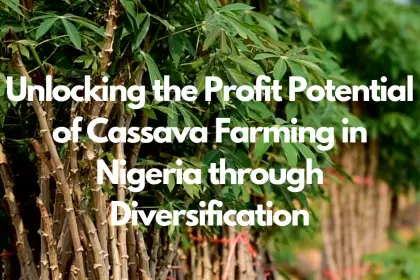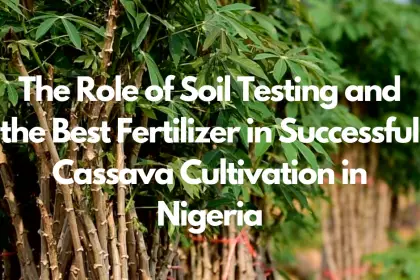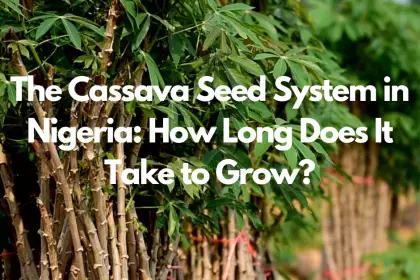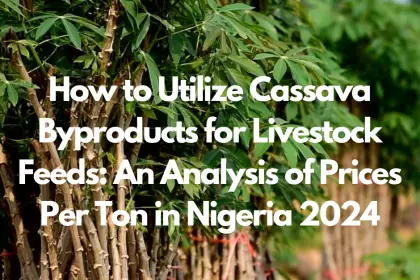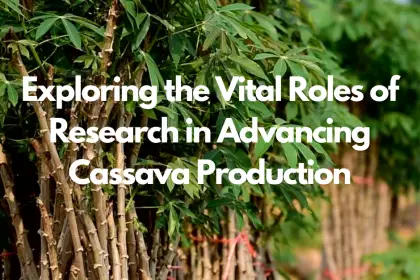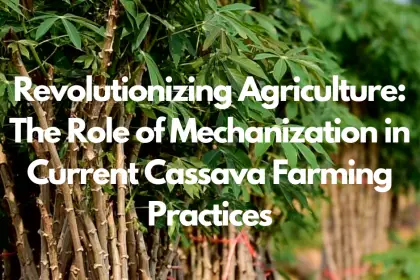Cassava farming stands as a cornerstone in the agricultural panorama of over 100 countries, particularly within the tropical and subtropical zones where this versatile crop thrives. Originating from the southern Brazilian Amazon roughly 9,000 years ago, cassava’s journey to becoming a staple for millions of smallholder farmers in regions like Nigeria is underscored by its resilience, requiring low-cost planting material and exhibiting tolerance to acid soils. Its pivotal role in food security is highlighted by its extensive cultivation in sub-Saharan Africa, where it constitutes a major food source.
Embarking on a path to enhance cassava yields involves a meticulous exploration of prime cassava varieties, land preparation nuances, and adopting integrated pest and disease management strategies. This article aims to provide a comprehensive guide on how to bolster cassava farming, courting enhanced productivity and profitability. Through embracing improved nutrient management and fertilization techniques, along with strategic harvesting and post-harvest handling, farmers can unlock the full potential of their cassava crops, reinforcing its significance in the farming landscape of countries like Nigeria and beyond.
Understanding Cassava Farming
Understanding the nuances of cassava farming is pivotal for enhancing productivity and sustainability. This section delves into key aspects that contribute to successful cassava cultivation, particularly in regions like Nigeria where cassava farming is not just an agricultural activity but a backbone of the rural economy.
- Cassava’s Role in the Rural Economy: In Nigeria, cassava is a linchpin of the rural economy, with a staggering annual production of over 34 million tonnes. This underscores the crop’s significance and the vast potential for yield improvement (FAO).
- Optimal Growth Conditions: Cassava thrives in a variety of soil types, thanks to its symbiotic relationship with vesicular-arbuscular mycorrhizae fungi, which aids in nutrient uptake. The plant’s resilience is further highlighted by its ability to produce reasonable yields on soils where other crops might fail. For optimal growth, cassava requires an annual precipitation of 600mm and a pH range of 3-8, reaching heights of 1-4 meters. Its tuberous storage roots, rich in starch, are the primary harvest (Agricdemy).
- Sustainable Farming Techniques: To preserve soil health and enhance cassava yields, it is essential to minimize mechanical disturbance, maintain soil cover, and promote biodiversity through crop rotation. These practices not only protect the soil structure but also reduce erosion, inhibit weed growth, and improve water retention, laying the foundation for high-yield cassava farming (Agricdemy).
Incorporating these insights into cassava farming practices can significantly boost yields, especially in Nigeria, where the potential for increased productivity remains largely untapped. By understanding the crop’s requirements and adopting sustainable farming techniques, cassava farmers can unlock the full potential of their farms.
Selecting the Right Cassava Variety
Selecting the right cassava variety is crucial for maximizing yield and ensuring the success of cassava farming in Nigeria. Here are key considerations and recommended varieties:
- Considerations for Variety Selection:
- Yield Potential: Opt for varieties with high yield potential to maximize productivity.
- Pest and Disease Tolerance: Choose varieties resistant to common pests and diseases like Cassava Mosaic Disease (CMD) and Cassava Brown Streak Disease (CBSD).
- Storability and Quality: Select varieties that store well and meet consumer quality expectations for products like garri, fufu, and flour.
- Agronomic Practices: Consider varieties that are well-suited to local farming practices, including intercropping and mechanization.
- Recommended Varieties:
- TME 419 Dixon (0581): Known for its high yield potential of about 36 tons per hectare, suitability for intercropping, and high dry matter content.
- Farmer’s Pride (1632): Produces high-yielding tubers up to 35 tons/ha, with good dry matter content suitable for starch and flour production, and resistance to CMD.
- Sunshine: A bio-fortified variety with high pro-vitamin A and yellow roots, suitable for yellow garri and other bio-fortified food products; it has good dry matter content and resistance to CMD.
Selecting the right variety involves balancing these factors to suit the specific conditions and goals of cassava farming in Nigeria. By choosing wisely, farmers can significantly enhance their productivity and profitability.
Land Preparation and Planting Techniques
To optimize cassava farming in Nigeria, focusing on land preparation and planting techniques is crucial. Here’s how to effectively prepare the land and plant cassava for enhanced yields:
- Land Preparation:
- Begin land preparation after the last harvest or during the fallow period, which should take about 3 to 4 weeks. This allows time for the soil to settle and nutrients to integrate.
- Ensure the land is not sandy or clayey. Ideal land has a flat or slight slope to prevent erosion. A sandy loam soil is preferred for bigger tuber sizes and avoiding flood-prone areas due to cassava’s high potash demand.
- Clear bushes to allow direct sunlight, which helps destroy parasites and disease vectors. However, burn bushes sparingly to prevent depleting soil nutrients.
- Uproot weeds and maintain a protective organic cover on the soil to prevent nutrient competition.
- Boost soil fertility by injecting animal manure or compost, which provides a complete nutrient package and reduces soil-borne diseases.
- Planting Techniques:
- Plan the outline of your vegetation, considering spacing and population. An optimal spacing is 1m x 1m apart along each row and across ridges.
- Plant cassava stem cuttings that are 25 cm long at the recommended spacing, maintaining a 100% cassava planting rate to ensure uniform growth.
- Apply agricultural lime during land preparation to improve soil suitability and use a total herbicide 10 days before land preparation, followed by a selective pre-emergence herbicide within three days after planting to control weeds effectively.
By following these land preparation and planting techniques, cassava farmers in Nigeria can significantly improve their farming outcomes, leading to greater yields and profitability.
Integrated Pest and Disease Management
In the realm of cassava farming in Nigeria, managing pests and diseases is a critical step toward securing high yields and sustainability. Here’s how to effectively implement integrated pest and disease management strategies:
- Pest Management:
- Cassava Green Mite: This pest can be controlled by planting early at the onset of rains. Utilize biological control methods, including predatory mites and parasites. Crop rotation and Integrated Pest Management (IPM) are also effective strategies.
- Cassava Mealybugs: Their natural enemy, a parasitic wasp, is an effective control method. Additionally, routine garden checks and planting resistant varieties play a crucial role in mealybug management.
- Disease Management:
- Cassava Mosaic Disease (CMD): Symptoms include chlorosis and mottling of leaves. Control methods encompass planting resistant or tolerant varieties, crop rotation with legumes, and utilizing disease-free planting material.
- Cassava Brown Streak Disease (CBSD): Manifested through venial necrosis and brown streaks on the stem. Control measures include using cuttings from disease-free areas, planting tolerant varieties, and uprooting diseased plants for destruction.
An integrated approach that combines biological, cultural, and chemical methods is recommended for effective pest and disease management. Biological control leverages natural enemies of pests, cultural control includes practices like crop rotation and the use of resistant varieties, and chemical control, though necessary, should be applied judiciously due to environmental concerns. Collaboration among farmers, researchers, and extension agents is vital for the successful implementation of these practices in cassava farming.
Nutrient Management and Fertilization
In the quest to enhance cassava farming in Nigeria, understanding the pivotal role of nutrient management and fertilization is crucial. This section delves into how farmers can optimize nutrient application for improved yields.
- Essential Nutrients for Cassava:
- Nitrogen (N), Phosphorus (P), and Potassium (K) are vital for cassava’s growth and development. N and P are crucial early in the growing season, while K becomes essential later to support the development of bulky roots. For a detailed insight into cassava’s nutrient needs, explore cassava fertilization requirements.
- Application Timing: Applying N, P, and K fertilizer 2 to 4 weeks after planting supports early growth. N should be applied in two or three splits to enhance N recovery efficiency and yield. A full dose of P in the first application aids root development, with K applied in two to three splits to minimize losses.
- Fertilizer Types and Application:
- Recommended Fertilizers: NPK 15:15:15, NPK 17:17:17, or NPK 20:10:10 are suitable compound fertilizers for cassava. For soils not analyzed, applying eight sacks of complete (14-14-14) fertilizer per hectare, 2-6 weeks after planting, can significantly boost growth. Discover more about the best fertilizer for cassava.
- Application Method: Create a full ring furrow about 20 cm away from each cassava plant, spread the required fertilizer in the furrow, and cover it with soil. This method ensures the nutrients are accessible to the plant’s roots, promoting efficient uptake.
By implementing these nutrient management and fertilization strategies, cassava farmers in Nigeria can significantly improve their crop’s health and yield, paving the way for more profitable farming practices.
Harvesting and Post-Harvest Handling
In cassava farming, the phases of harvesting and post-harvest handling are critical to ensuring high yield and quality, particularly in Nigeria. To achieve this, follow these guidelines:
- When to Harvest:
- Harvest cassava at full maturity, which is typically 6-7 months after planting, to ensure the roots have reached their maximum size and the starch content is optimal.
- Avoid harvesting immediately after heavy rain or when the soil is too wet. This precaution helps to prevent complications in storage due to high water content in the roots and soil adherence.
- Harvesting Techniques:
- Loosen compact soil around the cassava roots gently to minimize root damage. Use wooden tools instead of metal to reduce harm to the roots.
- Only harvest the amount needed for immediate consumption or processing within 2 days to prevent quality degradation.
- Post-Harvest Handling:
- Sun-dry newly harvested roots for 4 hours or less to facilitate soil particle removal before washing harvested roots to remove soil and foreign matter.
- For roots intended for starch or flour production, peel and slice them into thin slices, ideally not more than 5 mm thick.
- Spread chips evenly on bamboo or woven mats for sun drying, then store dried chips in pails with covers or sacks with cellophane lining to prevent moisture re-absorption.
Implementing these steps in cassava farming in Nigeria can significantly bridge the yield gap, enhance the quality of the produce, and increase profitability.
Conclusion
Throughout this exploration, we’ve traced the journey of maximizing cassava yield from selecting the right varieties and employing optimal farming techniques, to the crucial steps of harvesting and post-harvest handling. The integration of sustainable farming practices, along with a keen focus on nutrient management and pest control, stands as a testament to cassava farming’s potential in significantly contributing to food security and economic growth, particularly within Nigeria’s agricultural framework. The meticulous adoption of these recommendations not only promises to enhance productivity but also to elevate profitability for cassava farmers, positioning cassava as an invaluable asset in the global agricultural landscape.
Understanding the intricate dynamics of cassava cultivation underscores the importance of continuous learning and adaptation in agricultural practices. As we strive for improved yields and sustainability, exploring further advancements and resources becomes imperative. For farmers and agricultural enthusiasts keen on elevating their cassava farming journey, delving into additional insights and guidance can be a game-changer. To embark on this path of agricultural enlightenment and success, discovering more resources can provide the edge needed in today’s competitive farming environment.
FAQs
How Can You Enhance Cassava Crop Yields?
To boost cassava yields, it’s crucial to plant cassava stems either early in the morning or late in the evening to minimize evaporation losses. Proper spacing is also key, with a recommended distance of 1 meter by 1 meter between plants, allowing ample room for each plant’s nutritional needs.
What Strategies Can Make You Prosperous Through Cassava Farming?
Achieving wealth from cassava farming involves diversifying your crop portfolio. Intercropping cassava with leguminous crops like cowpeas, beans, and groundnuts can enhance soil fertility and farm profitability. Incorporating maize with cassava is another effective strategy for improving agricultural outcomes.
What Are the Maximum Yields Possible for Cassava?
In ideal conditions, cassava can produce as much as 80 tonnes per hectare, which is approximately 32.4 tons per acre. This high yield potential underscores the importance of optimal farming practices.
What Type of Fertilizer Is Most Effective for Cassava Cultivation?
For cassava cultivation, the most beneficial fertilizer is one that provides balanced nutrients. A compound fertilizer with equal parts nitrogen (N), phosphorus pentoxide (P2O5), and potassium oxide (K2O), in the range of 500 kg to 800 kg per hectare, is recommended. Formulas such as 15-15-15 or 16-16-16 are typically used to achieve this balance.


